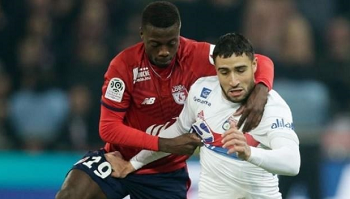The value of players in training and potential capital gains on purchased players: a "Trophée de l'immatériel" will be awarded in November to the Ligue 1 club with the best "hidden assets" and the best ability to transform them into cash.
J.LB. October 02, 2020 at 10h00 - L'Equipe

During the BIG event organized this Thursday in Paris by the BPI (Banque publique d'investissement), in the presence of the French President, five Ligue 1 clubs - Lille, Lyon, Marseille, Paris-SG and Saint-Étienne - were nominated for the Trophée de l'immatériel in the soccer category, an award that will be presented to one of them by the Observatoire de l'Immatériel on November 26 at the Institut National de la Propriété Industrielle (INPI).
A way to draw attention to the "hidden values" of professional soccer companies. According to Pierre Caillet, founder of the rating agency Ginkyo, who created the first "Barometer of the intangible assets of soccer clubs", "they are colossal".
The term "intangible" is used by financiers to describe all the values that are not included in a company's assets at a given moment, but which nevertheless contribute to its wealth. For clubs, whose players' capital is very often the number one asset, intangible assets are mainly found in their dressing rooms.
The intangible value of a workforce is three times its balance sheet value
"There is a paradox in the accounting of companies in general and clubs in particular: when value is created by the invention of a product, the creation of a brand or the training of a player, this value is not reflected in the balance sheet because it is not the result of a money transfer," points out Pierre Caillet. However, this unwritten value counts a lot, if only to evaluate the selling price of a club.
The first intangible value in soccer is the players in training who do not appear in the financial balance sheet of their club even though they have a value on the transfer market. Similarly, when a club spends X amount of money to buy a player, it is amortized over the duration of his contract, which means that the player's book value is quickly exceeded by his real value on the market - provided that he "shows his worth" through his performances.
Put together, the value of players in training and potential capital gains on purchased players constitute an estimated treasure trove for Ligue 1 of three times the value of the player capital recorded on clubs' balance sheets. As of June 30, 2019, the closing date of the 2018-2019 season's accounts, the average value of player capital on the balance sheet of an L1 club was €52.4 million, while the estimated value of that same squad on the transfer market reached €148.4 million. For more than 50% of clubs, the intangible value of their player capital far exceeds the value of their book assets.
OL champion for training values, PSG first for potential capital gains on players purchased
In detail - and not surprisingly - Olympique Lyonnais comes out on top in the ranking of potential capital gains on players trained at the club (only players who played more than 500 minutes in the first team were taken into account in the study). The French champion of training is ahead of PSG, OM, Nantes and, less expected at this level, Nimes, back in L1 in 2018-2019. " In addition to the promotion effect on the value of players trained at the club, their number in the pro squad that season played in their overall valuation, while the first of the ranking have created value on a more limited number of players but more expensive, "clarifies Pierre Caillet.
In the ranking of potential capital gains on purchased players, this time it is PSG that is ahead of OL. An effect in particular of the rocket Kylian Mbappé. By June 30, 2019, the world champion had already completed two of the five years of his contract in Paris. His purchase cost (€ 180 million) was therefore already partly amortized and his book value much lower than his estimated value on the market, € 200 million minimum at the time.
"The health crisis has caused the average value of the workforce to drop by about 20 percent"
Pierre Caillet, founder of the rating agency Ginkyo
Training high potential players and buying smart on the transfer market is not enough, it is also necessary to convert these promises into real cash. This stage, where the intangible is translated into cash, is the subject of the third and final ranking of the Barometer, where clubs are ranked according to the real overall capital gains they made during the 2019 summer mercato, both on players trained at the club and on the resale of purchased players. In this compartment of the game, OL is ahead of Lille by a handful of million euros, proof that two economic models coexist, one in Lille focused on player trading (all capital gains come from the resale of purchased players), the other in Lyon where the sale of trained players brings about a fifth of the overall capital gain.
The first Football Club Intangible Barometer is published in the particular context of the health crisis. How much has the value of players dropped since the agency produced its calculations? "The stoppage of the Ligue 1 has reduced the average value of players by around 20%," replies Pierre Caillet. But it is the real market that will give us the true extent of the phenomenon. It will be our job as soon as the market closes to analyze the reality of the impact of Covid-19 to adjust our mathematical models and re-evaluate the intangible wealth of the clubs." The market will close next Monday at 11:59pm.
Read the article on the website of l'Equipe





